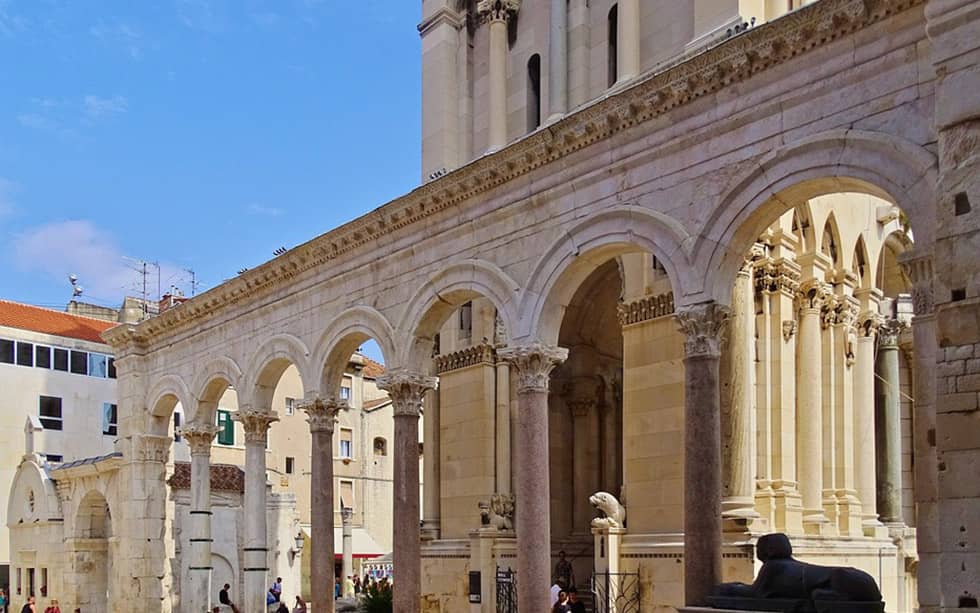Diocletian’s Palace is the heart of Split—a living Roman complex where locals still live, work, and eat inside ancient walls. Built as Emperor Diocletian’s retirement residence in the late 3rd to early 4th century, it later became the foundation of the medieval city and today forms part of Split’s UNESCO-listed historic complex.
On this page you’ll find quick answers, the best things to see inside the Palace, and practical tips to plan your visit (including what’s free vs ticketed). If you’re building an itinerary, also explore our Split attractions guide.
Diocletian’s Palace: quick answers
- What is it? A vast Roman imperial palace complex that later evolved into Split’s Old Town.
- Is it UNESCO? Yes—part of the UNESCO-listed historical complex of Split built around the Palace.
- Where is it? Central Split Old Town, between the Riva waterfront and the city streets behind it.
- What should I see first? Peristyle square, the Vestibule, the basement halls (cellars), and the Cathedral area (the former mausoleum).
- How long do you need? 45–90 minutes for highlights; 2–3 hours if you add cellars, museums, and stops for photos.
- Do I need tickets? Many outdoor areas are free to enter, but specific sites (like substructures/cellars and some interiors) can require tickets—check on-site and official listings for current access.
- Best time to go? Early morning or late afternoon for fewer crowds and better photos.
Best tours of Diocletian’s Palace
Because Diocletian’s Palace is not a traditional museum but a living part of the city, many of its most important details are easy to miss without explanation. A guided walking tour helps you understand how the palace was originally laid out, what each space was used for in Roman times, and how the ancient structure gradually transformed into the Old Town of Split.
Guides also provide context you won’t get from signage alone - from why the Peristyle was the ceremonial heart of the palace to how the underground cellars mirror the rooms above. If you have limited time in Split or want a deeper understanding of what you’re seeing, a guided tour is often the most efficient way to experience Diocletian’s Palace.
Split - "Emperor's City for History Lovers"
Private Walking Tour + Cellars Museum
This guided walking tour focuses on the highlights of Split’s Old Town, with special attention to Diocletian’s Palace, the Peristyle, and the impressive underground substructures. It is well suited to visitors who want historical context without rushing and prefer a more personal, in-depth experience.

Spalato (Split), started forming in the 7th century when nearby residents fled from barbarian invasions. As the palace was abandoned by the Romans and was empty for several centuries, its new residents started making their homes and workshops inside the walls. Today, within the palace itself, approximately 3000 citizens live in some 200 residential buildings. But with the many bars, shops and cultural events - that number rises dramatically, especially during summer.
Diocletian was buried in his palace. His tomb was later turned into a Christian church, the Cathedral of St. Domnius, which is still standing nowadays. Because of the fact that Diocletian persecuted Christians, while the palace wasn't in use anymore, they came back and destroyed all images and signs of Diocletian. Afterwords, many other sights were destroyed, built upon and similar. They replaced Roman-era imagery with Christian imagery.
The entire complex covered approximately 30,000 square meters and now lies at the heart of Split, Croatia. The ancient fortress has evolved into the old town, featuring shops, cafes, restaurants, and apartments within its historic buildings on the narrow streets of the palace. Want to see more of Split and it's surroundings? Check out the Best day trips from Split
The palace had four gates. The Golden Gate, located on the northern side, marked the start of the road leading to the town of Solin. The Silver Gate stood on the eastern side, the Iron Gate on the west, and the Bronze Gate faced the southern sea shore. While the gates themselves no longer exist, remnants of carved stone pillars and arches can still be seen at their original locations.
In November 1979 UNESCO declared the palace remains a World Heritage site as a important archaeological complex.
The Diocletian's palace was also featured on the back side of the Croatian 500,00 kuna banknote.
Working Hours
open 24 hours
Features
One of the most valuable building of the Roman era on the Adriatic coast
Address & contact details
Street: Dioklecijanova 1
Postcode: 21000
City: Split
Where to stay in Split
Our top picks for where to stay in Split.